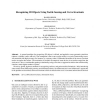Free Online Productivity Tools
i2Speak
i2Symbol
i2OCR
iTex2Img
iWeb2Print
iWeb2Shot
i2Type
iPdf2Split
iPdf2Merge
i2Bopomofo
i2Arabic
i2Style
i2Image
i2PDF
iLatex2Rtf
Sci2ools
JMIV
2000
2000
Recognizing 3D Objects Using Tactile Sensing and Curve Invariants
A general paradigm for recognizing 3D objects is offered, and applied to some geometric primitives (spheres, cylinders, cones, and tori). The assumption is that a curve on the surface, or a pair of intersecting curves, was measured with high accuracy (for instance, by a sensory robot). Differential invariants of the curve(s) are then used to recognize the surface. The motivation is twofold: the output of some devices is not surface range data, but such curves. Also, a considerable speedup is obtained by using curve data, as opposed to surface data which usually contains a much higher number of points. We survey global, algebraic methods for recognizing surfaces, and point out their limitations. After introducing some notions from differential geometry and elimination theory, the differential and "semi-differential" approaches to the problem are described, and novel invariants which are based on the curve's curvature and torsion are derived.
| Added | 19 Dec 2010 |
| Updated | 19 Dec 2010 |
| Type | Journal |
| Year | 2000 |
| Where | JMIV |
| Authors | Daniel Keren, Ehud Rivlin, Ilan Shimshoni, Isaac Weiss |
Comments (0)

